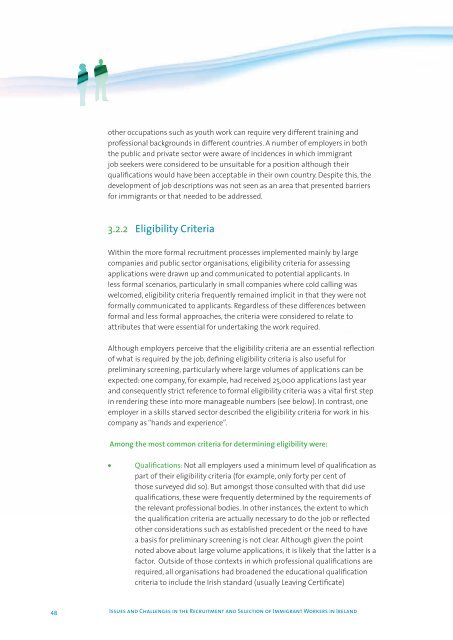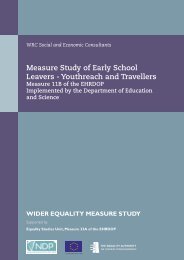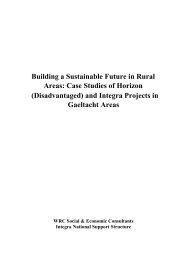Issues and Challenges in the Recruitment and Selection of ...
Issues and Challenges in the Recruitment and Selection of ...
Issues and Challenges in the Recruitment and Selection of ...
Create successful ePaper yourself
Turn your PDF publications into a flip-book with our unique Google optimized e-Paper software.
o<strong>the</strong>r occupations such as youth work can require very different tra<strong>in</strong><strong>in</strong>g <strong>and</strong>pr<strong>of</strong>essional backgrounds <strong>in</strong> different countries. A number <strong>of</strong> employers <strong>in</strong> both<strong>the</strong> public <strong>and</strong> private sector were aware <strong>of</strong> <strong>in</strong>cidences <strong>in</strong> which immigrantjob seekers were considered to be unsuitable for a position although <strong>the</strong>irqualifications would have been acceptable <strong>in</strong> <strong>the</strong>ir own country. Despite this, <strong>the</strong>development <strong>of</strong> job descriptions was not seen as an area that presented barriersfor immigrants or that needed to be addressed.3.2.2 Eligibility CriteriaWith<strong>in</strong> <strong>the</strong> more formal recruitment processes implemented ma<strong>in</strong>ly by largecompanies <strong>and</strong> public sector organisations, eligibility criteria for assess<strong>in</strong>gapplications were drawn up <strong>and</strong> communicated to potential applicants. Inless formal scenarios, particularly <strong>in</strong> small companies where cold call<strong>in</strong>g waswelcomed, eligibility criteria frequently rema<strong>in</strong>ed implicit <strong>in</strong> that <strong>the</strong>y were notformally communicated to applicants. Regardless <strong>of</strong> <strong>the</strong>se differences betweenformal <strong>and</strong> less formal approaches, <strong>the</strong> criteria were considered to relate toattributes that were essential for undertak<strong>in</strong>g <strong>the</strong> work required.Although employers perceive that <strong>the</strong> eligibility criteria are an essential reflection<strong>of</strong> what is required by <strong>the</strong> job, def<strong>in</strong><strong>in</strong>g eligibility criteria is also useful forprelim<strong>in</strong>ary screen<strong>in</strong>g, particularly where large volumes <strong>of</strong> applications can beexpected: one company, for example, had received 25,000 applications last year<strong>and</strong> consequently strict reference to formal eligibility criteria was a vital first step<strong>in</strong> render<strong>in</strong>g <strong>the</strong>se <strong>in</strong>to more manageable numbers (see below). In contrast, oneemployer <strong>in</strong> a skills starved sector described <strong>the</strong> eligibility criteria for work <strong>in</strong> hiscompany as “h<strong>and</strong>s <strong>and</strong> experience”.Among <strong>the</strong> most common criteria for determ<strong>in</strong><strong>in</strong>g eligibility were:• Qualifications: Not all employers used a m<strong>in</strong>imum level <strong>of</strong> qualification aspart <strong>of</strong> <strong>the</strong>ir eligibility criteria (for example, only forty per cent <strong>of</strong>those surveyed did so). But amongst those consulted with that did usequalifications, <strong>the</strong>se were frequently determ<strong>in</strong>ed by <strong>the</strong> requirements <strong>of</strong><strong>the</strong> relevant pr<strong>of</strong>essional bodies. In o<strong>the</strong>r <strong>in</strong>stances, <strong>the</strong> extent to which<strong>the</strong> qualification criteria are actually necessary to do <strong>the</strong> job or reflectedo<strong>the</strong>r considerations such as established precedent or <strong>the</strong> need to havea basis for prelim<strong>in</strong>ary screen<strong>in</strong>g is not clear. Although given <strong>the</strong> po<strong>in</strong>tnoted above about large volume applications, it is likely that <strong>the</strong> latter is afactor. Outside <strong>of</strong> those contexts <strong>in</strong> which pr<strong>of</strong>essional qualifications arerequired, all organisations had broadened <strong>the</strong> educational qualificationcriteria to <strong>in</strong>clude <strong>the</strong> Irish st<strong>and</strong>ard (usually Leav<strong>in</strong>g Certificate)48<strong>Issues</strong> <strong>and</strong> <strong>Challenges</strong> <strong>in</strong> <strong>the</strong> <strong>Recruitment</strong> <strong>and</strong> <strong>Selection</strong> <strong>of</strong> Immigrant Workers <strong>in</strong> Irel<strong>and</strong>




